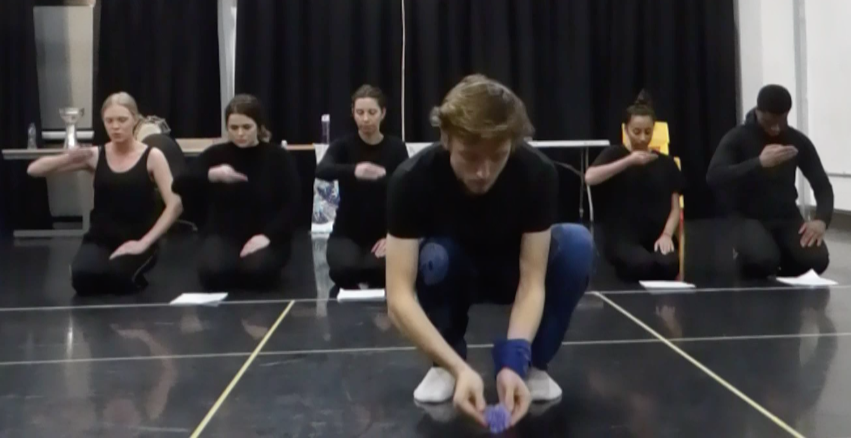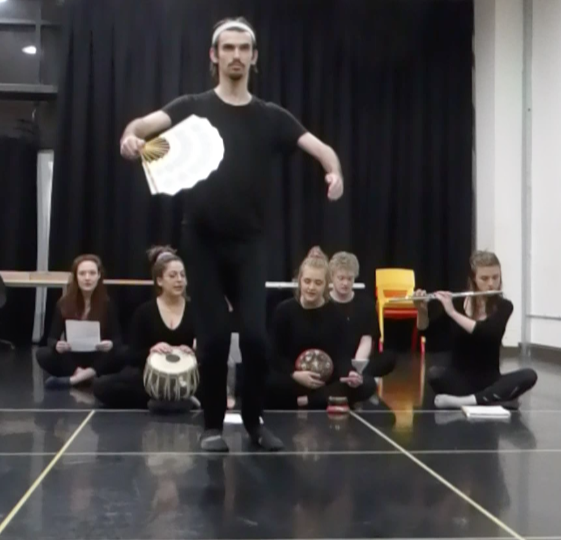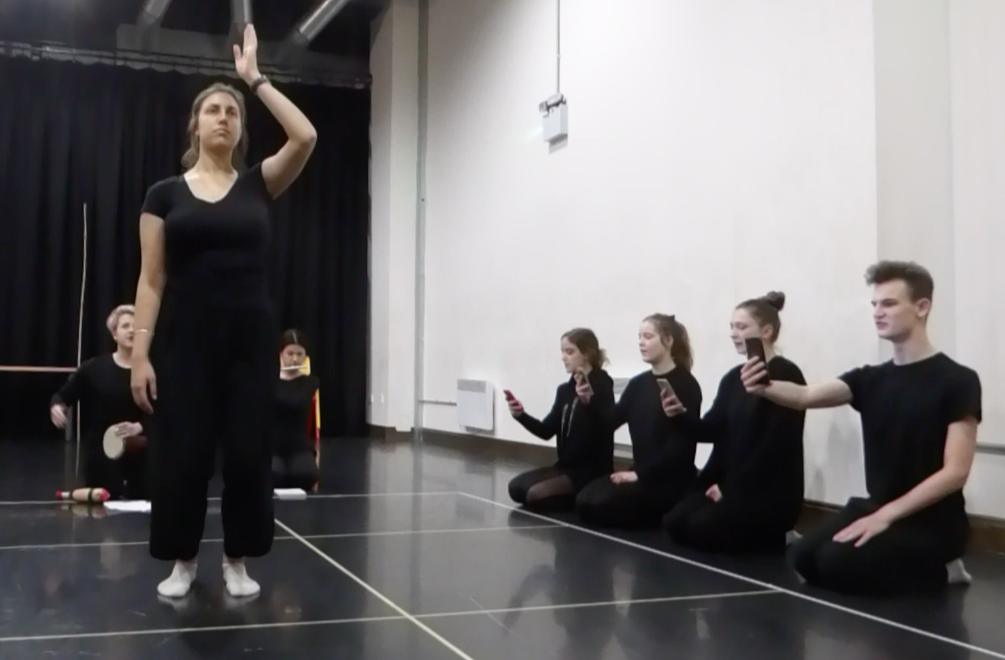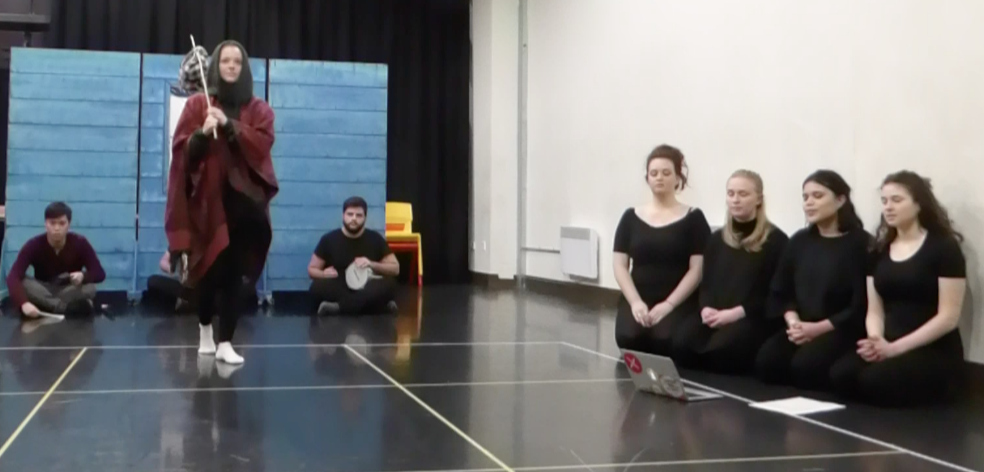22-25 January 2019
During a very busy ‘student’ working week Jannette participated in the delivery of a noh writing workshop at the invitation of Margaret (Jiggs) Coldiron. Jannette found her time (almost four days) with the students inspiring - especially their positive attitude to the project, dedication to understanding as much as they could about the art form and their keen interest to produce exciting original work in such a short time. Jannette felt each of the students’ projects had such great potential and was very moved by their storytelling skills and engagement with the project theme (we chose the same theme as Between the Stones, i.e. ‘finding peace and love from tragic loss’…)
Congratulations to all the students on their achievements and many thanks to Jiggs for the kind invitation to work with the 2nd year BA World Performance students at East 15 Acting School.
The project focused on some key principles of storytelling as applied to noh, but giving the students the flexibility to perform their work in a musical genre of their own choice… demonstrating how cultural fusion can occur through this form of storytelling… and with such fascinating results!
“I was astonished at what truly passionate, clear and moving work Jannette was able to draw from my World Performance students in her project on Noh: From Page to Stage. As both a scholar and lover of Noh I wanted my students to be able to engage with this exceptional art form, but I worried that the challenges of grasping both the Noh aesthetic and the structure of Noh plays might be more than could be accomplished in just a few days. However, Jannette’s careful management of the tasks required provided the students with the tools they needed to create some marvellous pieces that used Noh and their own ideas and experiences to create six exceptional poetic performances. I hope that we can repeat the project with more time that will allow the students to go even further. The project has won over this group to Noh and many want to go on to pursue deeper study of the form, while others are finding it a useful tool in their own creative work as playwrights and theatre-makers.”
The students performing their original work inspired by noh:






East 15 Acting School, University of Essex, 2nd Year BA World Performance Students
East 15 Getting to Noh Project: Three students’ detailed feedback:-
This short project was designed to introduce students to the key elements of writing for noh and to have a close up and interactive experience of how a new noh begins its journey. Working in small groups students were also asked to create a short piece using their own work drawing on what they have learned about storytelling and how this evolves from the page to the stage in a classical art form working with the theme: finding beauty, peace and love from tragic loss, but using their own musical genre as applied to either a newly created michiyuki ‘travel song’ or kuse ‘central song’.
“Q1: To what extent do you have a better understanding of key elements in storytelling for both classical and contemporary noh-related works?
Student Graded Responses: 5, 4, 5
Q2: To what extent have you been able to utilise your increased knowledge of noh to create a new piece of work?
Student Graded Response: 5, 4, 5
Q3: To what extent have you learned how a new noh in traditional style is conceived and created from page to stage?
Student Graded Response: 4, 4, 4
Q4: Which aspects of the Getting to Noh project made the greatest impression on you and why?
Student response1: The reading of Jannette’s poetry as it was very emotionally captivating and it made me connect to Noh more as I could actually enjoy the poetic side of it through language accessible to me. Also, the project was very well structured, consequently the whole process was very easy to follow.
Student response 2: The writing of the script - I was unfamiliar with how they were meant to be formatted (for example, the journey song maps out key geographical points), so it was interesting to learn how these were created. The poetry that can come out of this is quite inspiring.
Student response 3: The Jo-Ha-Kyu structure is powerful in creating and sustaining action and has also been useful in other modules such as playwriting.
Q5: What aspects of the project development have you most enjoyed and why?
Student response 1: The part in which the story and poetry were created. In a fairly short time and by use of “deadlines” the groups managed to come up with a story quite quickly which allowed us plenty of time trying to fit the story into the Noh form which I found very interesting and enjoyable. Getting to know the form and trying to understand the place of the characters within the form gave me a new perspective of the function of characters within a story. Also, the main elements of jo-ha-kyu and less is more, although they are very universal concepts were not as prominent in my thinking while creating new works as they are now. Having worked with these concepts and purposely trying to use these concepts in the pieces we were making, re-introduced them in my mind which will be definitely helpful for future creations.
Student response 2: Adding music to our poems was interesting because it looked at how music could support the text in setting the scene or creating an atmosphere.
Students response 3: I thoroughly enjoyed coming up with a concept for a Noh piece based around the theme of loss, and then creating a touching story about innocence and childhood. Writing a travel song for this story was an enjoyable process, as I liked researching the geography of our chosen location and intertwining it with the poetry.
Q6: What areas of learning presented the greatest challenge and what did you learn by working through the challenge?
Student response 1: Bringing page to stage was definitely the hardest part of the whole process. The main obstacle was trying to figure out how much of the visual Noh aspects we were going to use. What we learned, however, and this was initiated by the fact that we did not learn the Noh way of singing nor the very specific movements, is that by taking inspiration from the way of staging or use of space and artists we could fill this ‘empty’ form or silhouette and paint it in ourselves using our own skills.
Student response 2: I found that creating the narrative of the complete Noh play, as a means to better understand the poem we were writing, very challenging because I felt that the conventions we had to stick were not familiar to us. However, in the long run I feel pushing through this challenge lead to solid narratives with action instead of merely emotion were created.
Student response 3: The biggest challenge was trying to put the song/story on its feet due to the amount of time we were given, but through this I learned not to try and overcomplicate things and keep it simple, especially when given a short time-frame.
Q7: Do you feel you will be able to use any of this new learning in some way in the future? If possible, can you give some examples?
Student response 1: Definitely. The concepts Jo-ha-kyu and less is more are now one of the first thoughts I have when creating new works, especially when problems arise, they seem to help push the process forward again. Also the idea that a form is empty and with the understanding that one can fill it in themselves, is very useful as it gives you beacons or boundaries which will keep your feet on the ground as it were, it gives the creation a certain direction or grounding, while in the meantime recognizing the freedom of the space between gives you endless possibilities of creating without being completely lost. In general I think that is something useful to remember, it gives you guidance and support through your journey of ideas.
Student response 2: Adding music to our poems was interesting because it looked at how music could support the text in setting the scene or creating an atmosphere.
Student response 3: Writing poetry is not something I have a lot of experience in, so this project was a chance for me to explore outside my comfort zone. The aforementioned geography research and combining with song was a great experience, so this is definitely something I may try again in future.
”

